The Sisters of the Order of St. Benedict opened the first hospital in St. Cloud in 1886, planting seeds of compassion that have blossomed and grown for more than 125 years. Though the name and location changed, the spirit did not. In 1964, the Benedictine Sisters deeded all the hospital property to the newly formed St. Cloud Hospital Corporation as a gift, entrusting their work to the men and women willing to take it up. The values that spurred the Sisters to launch their healing mission have endured through the decades.
View some of the highlights of St. Cloud Hospital's rich history of care and compassion.
1850s-1870s
1857: The story of health care in Central Minnesota cannot be told without setting it within the history of Benedictine women in the area.
The Sisters of the Order of Saint Benedict in Stearns County, Minnesota, trace their heritage to Saint Walburg Abbey in Eichstätt, Bavaria. Six nuns immigrated to St. Cloud in 1857, moving to St. Joseph in 1863. They came to teach children of European settlers and to live monastic life on the frontier. True to their monastic heritage, how they served was determined by the community where they settled and needs they saw around them.
1880s-1890s
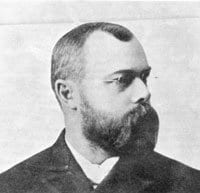 1882: On Aug. 24, the Benedictine Sisters in Saint Joseph wrote the St. Cloud City Council declaring their intention to establish a permanent hospital in St. Cloud, citing lack of such a health care facility and rapid population growth in the region.
1882: On Aug. 24, the Benedictine Sisters in Saint Joseph wrote the St. Cloud City Council declaring their intention to establish a permanent hospital in St. Cloud, citing lack of such a health care facility and rapid population growth in the region.
1885: In Sept., 1885, A.C. Lamothe Ramsay, MD, a Canadian who had settled in St. Cloud before completing his physician’s training in Chicago, opened a two-bed hospital on St. Germain Street in St. Cloud. In Dec. that year, Dr. Ramsay asked the Sisters for help. 
Mother Scholastica Kerst, OSB, responded immediately. She purchased a newly built house on what is now Ninth Avenue North in St. Cloud, then had it modified to serve as a 15-bed hospital equipped with an operating room and an office for Dr. Ramsay, the house surgeon.
1886: St. Benedict’s Hospital was dedicated Feb. 25. 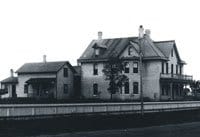
Despite enthusiastic news reports of the hospital’s opening and service to residents from surrounding towns, census lagged, and the Sisters thought of closing the hospital.
On April 14, a tornado ripped through St. Cloud, skipped across the Mississippi, and then nearly destroyed Sauk Rapids. Staff at the fledgling hospital provided such excellent care in the crisis that public opinion changed dramatically.
 1890: Within four years, need for hospital care grew so rapidly that the Sisters built a new, 30-patient bed facility across the Mississippi in southeast St. Cloud. St. Raphael’s Hospital, as it was called, was dedicated May 30.
1890: Within four years, need for hospital care grew so rapidly that the Sisters built a new, 30-patient bed facility across the Mississippi in southeast St. Cloud. St. Raphael’s Hospital, as it was called, was dedicated May 30.
1900s-1920s
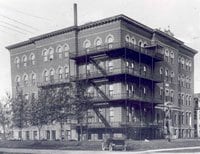 1900: Promises of a bridge and improved roads to the hospital failed to materialize. Poor access coupled with continued growth in the need for good hospital care compelled the Sisters to build a third hospital just 10 years later. Also called St. Raphael’s Hospital, the 50-bed facility with two operating rooms was constructed adjacent to the original hospital on Ninth Avenue North and was dedicated May 26.
1900: Promises of a bridge and improved roads to the hospital failed to materialize. Poor access coupled with continued growth in the need for good hospital care compelled the Sisters to build a third hospital just 10 years later. Also called St. Raphael’s Hospital, the 50-bed facility with two operating rooms was constructed adjacent to the original hospital on Ninth Avenue North and was dedicated May 26.
 1908: The new St. Raphael’s Hospital embraced progressive developments in applied medical science and nursing care. On Sept. 1, it opened St. Raphael’s Training School for Nurses. In 1928, the school became St. Cloud Hospital School of Nursing. It continued until June, 1987.
1908: The new St. Raphael’s Hospital embraced progressive developments in applied medical science and nursing care. On Sept. 1, it opened St. Raphael’s Training School for Nurses. In 1928, the school became St. Cloud Hospital School of Nursing. It continued until June, 1987.
1912: By 1912, the hospital had a trained radiologist on staff and equipment that allowed for diagnostic and therapeutic use of X-ray technology.
1916: The Sisters bought a 20-acre tract of land along the Mississippi 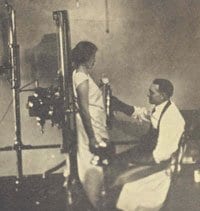 River for a new, fourth hospital.
River for a new, fourth hospital.
1926: The Benedictine Sisters hired a Chicago architectural firm to design their new hospital on the Mississippi River. To finance the state-of-the-art, 200-patient bed facility, the Saint Joseph Benedictines borrowed the immense sum of $2,000,000.
1928: On Feb. 9, St. Cloud Hospital on Sixth Avenue North was dedicated. It provided modern hospital services with compassionate care and first-rate medical technology.
1929: On Oct. 29, the United States stock market crashed, pulling the 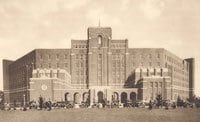 entire economy into the Great Depression that lasted 10 years. The impact on the hospital was profound. The hospital scrimped, recycled, improvised and innovated to reduce operating costs.
entire economy into the Great Depression that lasted 10 years. The impact on the hospital was profound. The hospital scrimped, recycled, improvised and innovated to reduce operating costs.
The entire Benedictine Order in Saint Joseph bore the burden of meeting interest payments on the hospital’s second mortgage. Low census forced the closing of one wing for a time. Still, no one questioned that St. Cloud Hospital would remain open for service.
1930s-1940s
1937: Sulfa drugs, the earliest antibiotics, were used for the first time at St. Cloud Hospital on Jan. 24.
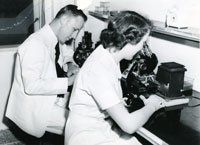 1942: St. Cloud Hospital started its School of X-ray Technology. The training program continues as St. Cloud Hospital’s School of Diagnostic Imaging, administered through the Imaging Department.
1942: St. Cloud Hospital started its School of X-ray Technology. The training program continues as St. Cloud Hospital’s School of Diagnostic Imaging, administered through the Imaging Department.
1945: St. Cloud Hospital opened its School of Medical Technology providing the intern year for college students preparing for hospital laboratory work. The school operated until 1995.
1950s-1960s
1953: Cases of poliomyelitis reached epidemic proportions in the United States after World War II. Young people were most vulnerable. By late summer 1953, Stearns and Benton counties were both listed as critical areas by the U.S. Public Health Service. A petition by local health officials for doses of the rationed serum gamma globulin to boost children’s immunity was granted and medicine quickly flown to St. Cloud.
Operation Lollipop — so called because local businesses donated lollipops to be given to those who endured the needle — conducted Sept. 9–11, 1953, was a very impressive collaboration between hospital and local communities. Volunteer physicians, nurses and lay people inoculated 25,850 children 14 years and under in 3 days at clinics set up at various sites in the two counties.
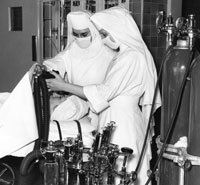 St. Cloud Hospital opened its School of Anesthesia in 1953. The school operated until 1976.
St. Cloud Hospital opened its School of Anesthesia in 1953. The school operated until 1976.
St. Cloud Hospital’s first set of triplets was born May 26, 1953.
In Nov., 1953, the first specialist in Obstetrics/Gynecology established practice in St. Cloud and joined the hospital’s medical staff.
1956: St. Cloud Hospital launched its own radio station, WELL, on Nov. 13.
1958: On July 9, local women organized the St. Cloud Hospital Auxiliary, under the supervision of the hospital’s chief administrator. Their three-fold mission was to assist where they could with the work of the hospital, sponsor projects to raise funds for the hospital’s benefit, and serve as hospital ambassadors to the local community.
 1961: On June 13, the St. Cloud Hospital Auxiliary began sponsoring Candy Stripers. This program aimed to introduce adolescent girls (ages 14-18) to the world of volunteering and to career possibilities in health care. In July, 1975, the organization opened to boys and changed its name to Junior Volunteers.
1961: On June 13, the St. Cloud Hospital Auxiliary began sponsoring Candy Stripers. This program aimed to introduce adolescent girls (ages 14-18) to the world of volunteering and to career possibilities in health care. In July, 1975, the organization opened to boys and changed its name to Junior Volunteers.
1962: St. Cloud Hospital opened a 10-bed Intensive Care Unit (ICU) on Jan. 10.
On Sept. 12, the St. Cloud Hospital was incorporated as a legal entity separate from the Sisters of the Order of Saint Benedict in St. Joseph. Then on January 17, 1964, the Sisters deeded ownership of the hospital’s land, buildings and equipment to the St. Cloud Hospital Corporation for the sum of one dollar. Board membership was expanded to include lay members of the local community.
1964: In July, St. Cloud Hospital opened an Emergency Room.
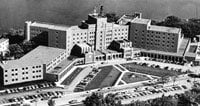 1966: Plans got underway for a massive $14 million expansion and renovation program that would update existing space, add patient bed capacity and accommodate new services. By June 12, 1974, the hospital would add a southwest wing, a northwest wing, an east addition and renovate virtually the entire 1928 building.
1966: Plans got underway for a massive $14 million expansion and renovation program that would update existing space, add patient bed capacity and accommodate new services. By June 12, 1974, the hospital would add a southwest wing, a northwest wing, an east addition and renovate virtually the entire 1928 building.
John Seckinger was hired to work in the business office. Mr. Seckinger would stay at SCH 42 years, until 2008. He was instrumental in establishing the hospital on very firm financial footing.
1967: St. Cloud Hospital hired its first Electronic Data Processing (later, Information Services) coordinator in Jan.
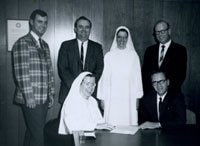 Gene S. Bakke, the first lay person to serve as the hospital’s chief administrator, began work June 1. One hallmark of his tenure was advancing the hospital’s service through collaborative models of management. He selected a team of assistant administrators to lend expert advice and leadership in five areas: Sister Paul Revier, OSB, RN, Nursing; Harry Knevel, Other Professional; Sister Colleen Haggerty, OSB, General; John Seckinger, Financial and Tom McLaughlin, Administrative.
Gene S. Bakke, the first lay person to serve as the hospital’s chief administrator, began work June 1. One hallmark of his tenure was advancing the hospital’s service through collaborative models of management. He selected a team of assistant administrators to lend expert advice and leadership in five areas: Sister Paul Revier, OSB, RN, Nursing; Harry Knevel, Other Professional; Sister Colleen Haggerty, OSB, General; John Seckinger, Financial and Tom McLaughlin, Administrative.
1968: In Sept., St. Cloud Hospital opened its in-patient Mental Health unit, complementing tri-county out-patient services.
1970s-1980s
1970: Cancer treatment began at St. Cloud Hospital when the first Hematology-Oncologist joined the medical staff in 1970.
1971: In May, 1971, St. Cloud Hospital opened its new Pediatric Unit.
St. Cloud Hospital took on management of Albany Community Hospital in Feb., 1971.
St. Cloud Hospital admitted its first patient to the new Alcohol and Chemical Dependency Treatment Unit (later, Recovery Plus) on July 12.
The first total hip replacement at St. Cloud Hospital was done in Dec.
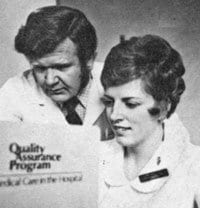 1973: St. Cloud Hospital opened its Psychology department.
1973: St. Cloud Hospital opened its Psychology department.
1974: St. Cloud Hospital hired its first Quality Assurance Nurse Coordinator.
St. Cloud Hospital’s first Neurosurgeon joined the medical staff.
1975: On April 23, St. Cloud Hospital announced its Board of Trustees’ decision to expand hospital services to aging and extended care patients. This resolution would take shape as St. Benedict Center (later, St. Benedict’s Senior Community).
Beginning in June, 1975, the Roman Catholic diocese of St. Cloud joined the Sisters of the Order of Saint Benedict, St. Joseph, Minnesota, in sponsoring St. Cloud Hospital.
1978: St. Benedict’s Center, a 220-bed nursing home constructed near the site of the 1890 St. Raphael’s Hospital in east St. Cloud, was dedicated April 12.
1980s: The 1980s saw the development and expansion of specialty care at St. Cloud Hospital, with outreach to surrounding communities in Central Minnesota. These specialties included:
- cancer treatment
- cardiology
- gastroenterology
- neonatology
- nephrology
- urology
1980: Hospice care began at St. Cloud Hospital with the admission of its first hospice patient Jan. 10. The Hospital’s Home Care program began in April, 1982.
1983: St. Cloud Hospital’s first Cardiologist joined the medical staff.
1984: Strategic planners made the decision to develop St. Cloud Hospital as a regional medical facility.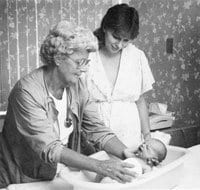
1987: In July, St. Cloud Hospital completed construction of a clinic building on its campus. St. Cloud Clinic was the first to lease office space.
1988: Family Birthing Center opens a renovated service and space.
First Neonatologist joined St. Cloud Hospital’s medical staff and started its Neonatology program.
1990s-2000s
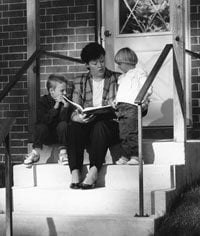 1990: On Jan. 3, St. Cloud Hospital’s Alcohol and Chemical Dependency Services (now, Recovery Plus) opened Journey Home, an innovative 16-bed extended care facility for chemically dependent women (18 and older) and their children, that provides transition from a primary treatment program to independence. In Oct., 2007, a new 68-bed home opened.
1990: On Jan. 3, St. Cloud Hospital’s Alcohol and Chemical Dependency Services (now, Recovery Plus) opened Journey Home, an innovative 16-bed extended care facility for chemically dependent women (18 and older) and their children, that provides transition from a primary treatment program to independence. In Oct., 2007, a new 68-bed home opened.
On Sept. 24, 1990, Mid-Minnesota Clinic (now CentraCare Family Health Center) opened in order to provide primary care for under-and uninsured individuals in the St. Cloud area. In its early years, the Clinic was staffed almost entirely by volunteer physicians, nurses and support personnel.
1993: Patient care at St. Cloud Hospital was divided into seven care centers:
- Central Minnesota Heart Center
- Medical/Oncology
- Behavioral Medicine
- Ortho/Neuro/Rehab
- Parent, Child & Women’s Services
- Home Care
- Surgical Services
For the first time St. Cloud Hospital was named one of the nation’s 100 Top Hospitals® by Thomsen Reuters (Healthcare; later, Truven Health Analytics) in 1993. The designation recognizes excellence in clinical outcomes, patient safety, financial performance, efficiency and growth in patient volume.
1994: In Sept., Corporate membership, formerly composed of representatives of the Benedictine Sisters in St. Joseph and the Catholic diocese of St. Cloud, expanded to include lay people. This body is charged with appointing members to the St. Cloud Hospital Board and with overseeing the hospital’s Catholic mission.
1995: On Feb. 2, St. Cloud Hospital and St. Cloud Clinic of Internal Medicine agreed to develop CentraCare, a not-for-profit integrated health care delivery system. CentraCare Health System began service July 3, 1995. St. Cloud Clinic of Internal Medicine became CentraCare Clinic. John Frobenius, president of St. Cloud Hospital, and Terence Pladson, MD, president of the Clinic, each retained his leadership role with his organization and, at the same time, became co-president of CentraCare Health System.
1996: Surgical Consultants of St. Cloud joined CentraCare Clinic.
In May, Melrose Clinic and Hospital became part of CentraCare Health System.
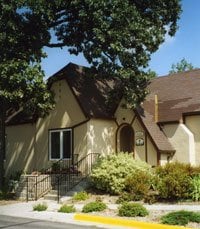 In Oct., St. Cloud Hospital opened River Oaks Hospitality House for patients and their family members needing temporary lodging during treatment.
In Oct., St. Cloud Hospital opened River Oaks Hospitality House for patients and their family members needing temporary lodging during treatment.
The CentraCare Health Foundation was formed in Dec.
Mid-Minnesota Clinic (now, CentraCare Family Health Center) launched a family practice residency program in collaboration with Mayo Clinic. The program now is sponsored by the University of Minnesota School of Medicine.
1997: In June, St. Cloud Women & Children’s Clinic joined CentraCare Clinic.
1998: Project H.E.A.L. (Health, Education, Access, Link) began as an outreach program of Mid-Minnesota Family Medicine Center (now, CentraCare Family Health Center) in collaboration with Place of Hope ministry on Ninth Avenue North.
In Oct. the Alexandria Radiation Oncology department was established.
In Oct. construction begun on St. Benedict’s Center, Monticello.
In Dec., Long Prairie Clinic and Hospital became part of CentraCare Health System.
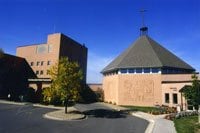 St. Cloud Hospital was rated a Level II trauma center by the American College of Surgeons.
St. Cloud Hospital was rated a Level II trauma center by the American College of Surgeons.
1999: St. Benedict’s Center was renamed St. Benedict’s Senior Community
2000: In Sept., Central Minnesota Radiation Oncology, Ltd. joined CentraCare Clinic.
2001: On July 5, CentraCare Clinic physicians began staffing St. Cloud Hospital with Hospitalists. Trained as internal medicine physicians, Hospitalists care exclusively for hospital patients.
In late fall, CentraCare Health Plaza opened for service. The Plaza, which houses hospital and clinic outpatient services, hosted its Grand Opening on Jan. 6, 2002.
CentraCare Health System joined Life Link III in 2001. Three-member crews are on duty around the clock to respond to calls for critical care air transport to the hospital.
2003: Jan. 2, Craig Broman assumed responsibilities as St. Cloud Hospital president and Terence Pladson, MD, became sole president of CentraCare Health System.
2004: On June 14, the American Nurses Credentialing Center recognized St. Cloud Hospital’s excellent nursing service by designating it a Magnet hospital. The hospital received re-designation in 2009 and 2013.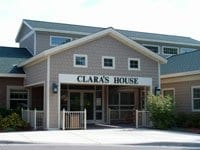
On Oct. 15, St. Cloud Hospital opened Clara’s House, a community-supported facility providing treatment for children and adolescents with emotional or behavioral needs.
2005: On Sept. 23, surgeons performed the first robotic surgery at St. Cloud Hospital using the da Vinci® Standard System.
2007: On Dec. 6, quintuplets arrived at St. Cloud Hospital’s Neonatal Intensive Care Unit.
On Feb. 6, Information Services orchestrated St. Cloud Hospital’s electronic medical record go-live to the Epic system.
2008: In Jan., Big Lake Clinic joined CentraCare Health System in a Joint Venture.
In Oct., Monticello Cancer Center joined CentraCare Health System in a Joint Venture.
In Nov., Brainerd Heart Center became a Clinical Partner.
In fall, 2008, construction began on a 360,000 square-foot wing on the hospital’s southeast side. The expansion, completed in 2013:
- added state-of-the-art surgical suites
- increased the number of private
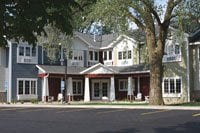 rooms
rooms
- enlarged the Neonatal Intensive Care Unit
- replaced the cramped, 25-year-old Intensive Care Unit.
2009: St. Cloud Hospital’s Gorecki Guest House welcomed its first guests on June 15.
2010s
2010: On Feb. 1, Information Services moved virtually all of CentraCare Health System’s medical records to the same electronic system, Epic.
2011: In July, Lakeview Clinic, Sauk Centre joined CentraCare Clinic.
2012: In Dec., 2012, St. Michael’s Hospital & Nursing Home, Sauk Centre joined CentraCare Health System.
2013: April, “CentraCare Health” became the new, shortened name designating the system and preceding the individual names of each entity that is part of it.
On April 1, CentraCare Health – Monticello (previously New River Medical Center) signed a long-term lease with CentraCare Health.
On Oct. 1, CentraCare Health-Paynesville signed a long-term lease with CentraCare Health.
2014: In December, Terence Pladson, MD, MBA, FACPE, the president/CEO of CentraCare Health retired.
2015: On Jan. 1, Kenneth Holmen, MD, begins his tenure as president/CEO of CentraCare Health.
“Honoring the Gift of Life”, a tribute wall at St. Cloud Hospital, was dedicated to organ, tissue and eye donors.
In October, the Gorecki Guest House completed an expansion project that brought the number of guest rooms from 12 to 28.
Linda Chmielewski, RN, vice president of hospital operations and chief nursing officer, retired Dec. 31 after 34 years of service.
2017: In May, Affiliated Community Medical Centers and Rice Memorial Hospital, both based in Willmar, Minnesota, took the first steps toward affiliation with CentraCare Health.
St. Cloud Hospital is named one of the nation’s “2017 Most Wired hospitals” by Hospitals & Health Networks magazine.